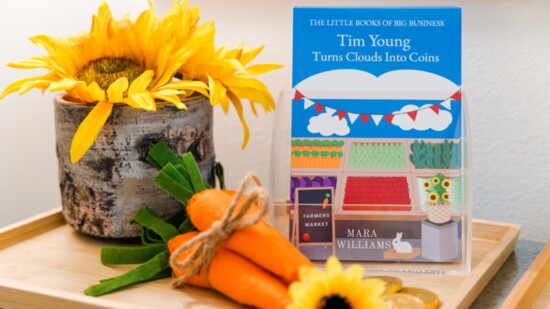By combining her experience as a small business owner and certified business coach with the desire to write books, Mara Williams is creating delightful books, called The Little Books of Big Business, which introduce children to financial literacy concepts.
What prompted you to create this series?
I wanted to write a book so I chose things I love including my favorite dessert (brownies), my favorite season (fall) and my love for coaching small business. I also enjoy youth fiction, so I wrote the series to teach people of all ages about entrepreneurship and financial literacy in a fun and simple way.
I wrote my first book, Cat Casey Turns Brownies Into A Business, but set it aside for a while. More stories kept coming and it ended up being a series of books with a total of four kids in the books who each start their own business. After getting helpful feedback, I published them so that kids would be inspired to start learning about business and money.
What specific topics do the books cover?
The books all cover entrepreneurship, the idea of developing a concept about a business, resourcing, and putting together an actual business. These are micro businesses for kids like selling baked goods, dog walking, and being a kid handyman. Kids learn entrepreneurial skills like business planning, cost of goods, and writing up an invoice. They also learn soft skills like communicating with adults, confidence and creativity. Those skills are layered with basic financial literacy standards like spending and saving, earning money and financial decision-making.
What types of resources are available?
The first four books (Cat Casey Turns Brownies Into A Business, Emma Mason Turns Paperwork Into A Profit, Max England Turns A Pet Project Into Pay, and Nick Frank Turns Carpentry Into Cash) are available as individual books wherever books are sold.
I’ve also created a fun resource called a Kidpreneur Kit. It is the collection of all four books along with engaging activity sheets, stickers, blank business cards, and money envelopes in a cute briefcase bag. Kids can read the books, make their own business cards, and use the money envelopes to budget their money.
In May I published a fifth book, Tim Young Turns Clouds Into Coins, that is specific to the farmers market. There are two new characters who each design their own product to sell at the farmers market by using the worksheets that are built into the book. This book was inspired by the collaboration I do with the Snohomish Farmers Market and the Snohomish Chamber of Commerce. This year we have forty kids in our Kid Vendor Day program and the kids are reading this book to learn and design their own farmers market business.
Additionally, I have been getting requests for curriculum, and so I started something new called “Let’s Play Money.” These are printable activity packets that follow the Washington state financial literacy standards for grades Kindergarten to sixth grade. Each packet includes all kinds of fun articles about money, crossword puzzles, coloring pages, and activities for practicing and playing with money.
Why do you think it is important to teach kids financial literacy concepts?
Studies show that kids’ behaviors about money are set between the ages of seven and nine. I feel like there's a sweet spot for kids who are in grade school as they are open to learning about money before they become teenagers. Teens feel like they should already know all these things and they're embarrassed or confused when they haven’t had financial practice and they need to make big decisions about their future. If we can get them when they are in grade school and willing to play and make mistakes, they can learn and build their capabilities about money.
What do you love about what you do?
I get major satisfaction from kids being super hungry for this topic. They're smart and learning about money is empowering. I was recently in a fourth-grade classroom and helped the kids play a “marketplace” activity. They were so energized by creating their own businesses, selling their products to each other and practicing for real life. It makes me feel good that they are getting experience now so that when they're ready to make financial decisions they've had some practice.
What is an important piece of advice you’d like to pass along to parents?
Cash is a missing piece we are facing with what I call “money technology”. Everything kids see today is plastic or digital. They have lost the opportunity to learn the value of money. I really encourage parents to find ways to integrate cash into the world.
For more information, visit http://www.thelittlebooksofbigbusiness.com. Find additional resources by following The Little Books of Big Business on YouTube, Facebook, and Instagram.
Studies show that kids’ behaviors about money are set between the ages of seven and nine. I feel like there's a sweet spot for kids who are in grade school as they are open to learning about money before they become teenagers. Teens feel like they should already know all these things and they're embarrassed or confused when they haven’t had financial practice and they need to make big decisions about their future. If we can get them when they are in grade school and willing to play and make mistakes, they can learn and build their capabilities about money.
I wrote the series to teach people of all ages about entrepreneurship and financial literacy in a fun and simple way.
